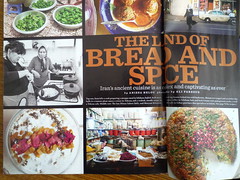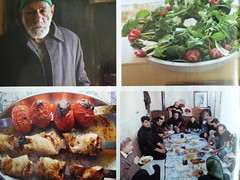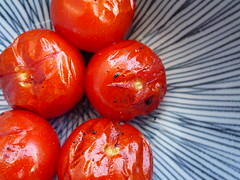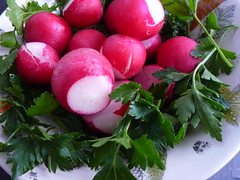Thrill of the Grill 3
Last year, we started a series on relatively quick grilling recipes, such as grilled sardines and Thai grilled pork skewers. As I wrote at the time, there are times when you want to get fully invested in "slow and low"-style barbecue, in making use of smoke's considerable powers as both a tenderizer and a flavour enhancer. But there are other times when,
you just want the pure thrill of the grill. You want the slight blackening, the light smokiness, the caramelized flavors, and the primal pleasures of cooking directly over flames. You want the payoff to come sooner rather than later. You want to take full advantage of the fact that cooking over a hot grill can be quick and easy.
Well, it's that time of year again. Our fully winterized balcony is a thing of the past, the barbecue is back in its place of honour, and our 2012 smoking and grilling season is well underway. And one of the best recipes I've tested out in recent weeks is another relatively quick grilling recipe that takes us to an entirely different region of the world: Iran.
 fig. a: land of bread & spice
fig. a: land of bread & spiceThe recipe appeared in an article on the cuisine of Iran in the March 2012 issue of Saveur by Anissa Helou ("The Land of Bread and Spice"). The article begins with a rather unexpected anecdote about a meal at Ava Gardner's house in London in 1982, but it proceeds to make a case for the centrality of Iran's "complex and captivating" cuisine to the world's foodways (both geographically and culturally)--at least those of Europe, North Africa, the Middle East, Central Asia, and South Asia. And it's a pretty convincing case.
Helou's account of modern-day Iranian cuisine in Tehran, Isfahan, and beyond, encompasses everything from home cooking, to restaurants, bakeries, and cafés, and, as the title suggests, it focuses on Iranian staples like spices and herbs, bread, and rice, of which she writes, "I've never seen so many different ways of cooking rice as I did in Iran," before describing the care which goes into making their revered polows. Her text had me pretty hooked on the idea of cooking Iranian already, but Ali Farboud's photographs really clinched things. Sometimes the anti-aesthetics of some of Saveur's food photography leaves me a bit cold, but, here, the article came with a photo-essay that lived up to the scope of Helou's article, and that I found positively enchanting. That said, the photographs that I gravitated to on the afternoon that I read the article were among the least exotic and the most familiar: Farboud's photographs of sabzi, the herb salad that's a staple of the Iranian table, and of jujeh kabab, spiced chicken and tomato kebabs. I was looking for a quick grilling recipe at the time, and that was exactly what I found.
 fig. b: land of sabzi & kebabs
fig. b: land of sabzi & kebabsActually, the recipe itself didn't hurt, either. When I flipped to page 76 and found the recipe for jujeh kabab, its intoxicating blend of yogurt, citrus, and spices leapt off the page. I felt like I had a pretty clear idea of just how succulent these kebabs were going to be, and the recipe didn't disappoint in the least. A few hours later, when Michelle came home to a spread of jujeh kabab, sabzi, a garlicky yogurt spread, fresh limes, and grilled flatbreads, she couldn't believe her luck.
 fig. c: Iranian-style chicken kebabs
fig. c: Iranian-style chicken kebabs fig. d: lightly charred tomatoes
fig. d: lightly charred tomatoesJujeh Kabab (Spiced Chicken and Tomato Kebabs)
1 cup plain yogurt
1/2 cup fresh lime juice
2 tbsp olive oil
2 tbsp orange zest
1 tbsp ground cumin (preferably toasted and freshly ground)
1 tbsp kosher salt
1 tbsp ground black pepper
2 tsp crushed saffron
1 tsp ground coriander
6 cloves garlic, minced
1 large yellow onion, sliced
2 lbs boneless, skinless chicken thighs, cubed
4 plum tomatoes
ground sumac, to garnish
2 limes, halved
grilled flatbreads, for serving
Stir together the yogurt, lime juice, olive oil, zest, cumin, salt, pepper, saffron, coriander, garlic, and onions in a bowl. Chop the thighs into large cubes, roughly 1-1 1/2" x 1 1/2-2". Add the chicken to the yogurt mixture, and toss to coat. Chill for 4 hours (you can "chill," too, but make sure you've placed the chicken in the fridge at least four hours before you intend to grill).
When the chicken has been properly marinated, build a medium-hot fire in a charcoal grill. Skewer the chicken on flat metal skewers (Iranian-style), or on wooden skewers that you've had the foresight to pre-soak. Add the tomatoes to another skewer. Grill the chicken and tomatoes, turning often, until tomatoes are soft and charred, about 7 minutes, and the chicken is cooked through and slightly charred, about 10-15 minutes. (I recommend starting the chicken directly over the medium-hot fire, charring the meat on all sides, and then moving the skewers to indirect heat for the remaining time.) Sprinkle the skewers with sumac. Brush the flatbreads lightly with olive and grill quickly.
Serve with the limes and the hot flatbreads.
Serves 4.
 fig. e: herbs & radishes
fig. e: herbs & radishesSabzi
watercressIf you've been slow to kick off this year's grill & barbecue season, let the flames begin.
mint leaves
parsley leaves
radishes
aj












